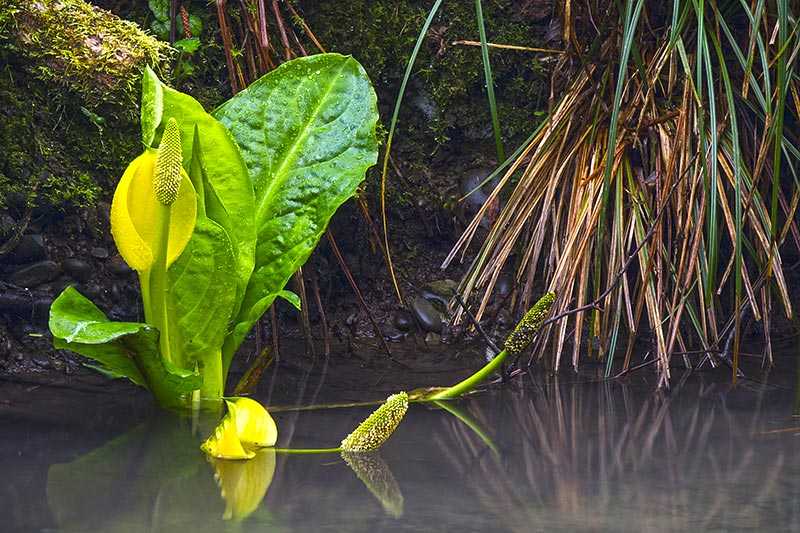7 Weird and Deadly Plants Growing Around The World

Over millions of years plants have evolved to protect themselves from harm using ingenious, and often, deadly methods! Featuring poisonous spines, deadly berries and hypnotising toxins, these seven plants are amongst the most bizarre and deadly in the world.
1. Skunk Cabbage (Lysichiton americanus)
If you were trying to compose a list of foul odours, ‘skunk’ and ‘cabbage’ might very well be amongst them! If you ever come across a Skunk Cabbage, you’ll instantly understand where its name originates. Hiding within the swamps of North America, this member of the Arum family exudes a foul, pungent odour, which is often mistaken for the stench of an angry skunk. This faecal scent has evolved as a mechanism for attracting insects, and is in no way harmful to humans or wildlife. Ingesting the leaves, on the other hand, is potentially deadly. Containing calcium oxalate, an extremely corrosive toxin, Skunk Cabbage can cause internal burning and organ failure.
2. Buttercup (Ranunculus acris)
You certainly wouldn’t expect the lovely buttercup to show up on a list of deadly plants. This innocent looking flower, however, is quite deceptive, and actually plays host to a harmful toxin. On contact with human skin, the buttercup causes a red rash to appear. Much more worryingly is the potentially deadly effects from ingestion. Grazing animals often unwittingly eat buttercups, and suffer gastrointestinal toxicity as a result. If a human was to eat too many buttercups then they could suffer a very painful death! With this in mind, it’s probably best to enjoy the beautiful buttercup from a distance!
3. Giant Hogweed (Heracleum mantegazzianum)
An invasive species and noxious weed, Giant Hogweed generally grows to between 2 metres and 5 metres in height, although is known to reach a staggering 7 metres. The root, stems, seeds, flowers and leaves (so basically everything!), contain furocoumarin derivatives. These derivatives cause Phytophotodermatitis in humans, which results in blisters, scars and blindness.
4. Angels Trumpet (Brugmansia)
Native to South America, the magnificent Angels Trumpet is truly beautiful to look at. However, it contains a number of harmful poisons, including the fascinating scopolamine. Almost like something out of a science fiction film, this toxin has hypnotising, zombie-like effects on those who ingest it. Unfortunately, gang members in South America harvest the toxin from Angels Trumpet to torture and manipulate victims. In a 2007 documentary, “Columbian Devils Breath”, the effects of the drug were revealed, detailing how one man had the toxic powder thrown in his face by robbers, causing him to fall into a zombie-like state. This trance resulted in him helpfully loading his own belongings into the robbers’ van for them!
5. Spurge Laurel (Daphne laureola)
This glossy-leaved, small evergreen shrub is native to the UK. An attractive, unassuming plant, it has the potential to cause an unpleasant and swift death if ingested by humans. Consuming just a few berries will result in massive organ failure and internal bleeding.
6. Red Tide Algae
Red Tide Algae is a phenomena rather than a species of plant! This algal bloom occurs when a collection of dinoflagellates species come together in such a high concentration that they turn the sea a reddish, brown colour. Some speculate that it’s possible the Biblical story of water turning to blood was based on Red Tide Algae. If you were to have contact with the neurotoxic water during one of these blooms, your limbs would be quickly paralysed and your respiratory pathways anesthetised.
7. New Zealand Tree Nettle (Urtica ferox)
You wouldn’t imagine that a deadly plant could kill you simply by treading on it! However, the New Zealand Tree Nettle has caused the death of a man who was unfortunate enough to have skin contact with it. As you might expect the Tree Nettle is native to New Zealand, and features a large woody stem with long stinging spines. Being stung by this nettle can cause polyneuropathy, which is a degenerative breakdown of the nervous system pathways. Having the ability to recognise this plant is crucial to staying safe whilst hiking in New Zealand!